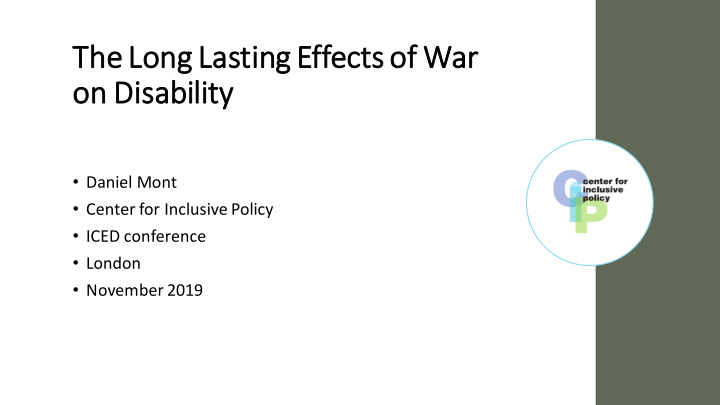



The e Long Lastin ing Effec ects of War on Disa sabilit lity • Daniel Mont • Center for Inclusive Policy • ICED conference • London • November 2019
Joint Paper with… • Michael Palmer (University of Western Australis • Cuong Nguyen (National Economics University, Hanoi) • Sophie Mitra (Fordham University) • Daniel Mont (Center for Inclusive Policy) • Nora Groce (University College London)
Does war have effects on disability in the long run? This paper estimates the long-term impact of US bombing over the period 1965-1975 on disability prevalence in Vietnam four decades later.
Motivation • The toll of warfare is typically assessed in terms of the number of people killed during war. • Wars may also have long lasting impacts after wars end through the continued exposure to unexploded ordinance, chemical weapons and indirectly through damaged infrastructure. • In Vietnam, an estimated one million Vietnamese lives were lost during the 1964-75 wartime period (Hirschman et al., 1995). The long-term impacts of the war on the health of the Vietnamese population remain little documented.
Data, Measures, and Models Warfare intensity • The data is from a database assembled by US Govt • Density of bombs, measured by the total number of bombs, missiles and rockets per km2 dropped by allied forces. • This measure picks up exposure to correlated weapons including UXO, mines and dioxin.
Data, Measures, and Models Washington Group Short Set minus the self-care and communication questions: Namely, The disability questions 15-percent sample of are four of the six questions Disability 2009Vietnam Population and recommended by the United (a) Housing Census seeing, (b) hearing, (c) walking/climbing stairs, (d) concentrating or remembering things. Disability: difficulty of any degree Severe disability: a lot of (some difficulty, a lot of difficulty difficulty or unable to do in at or unable to do) in at least one least one functional domain. functional domain.
Bombing and Severe Disability Prevalence Data, Measures and Models
Disability rates by birth dates
Log( Disability i )= α+β Log( bomb i )+ θ X i + u i Estimation where … Log( bomb i ) is the log of bomb density of Strategy: district i Ordinary Least X i includes district area and elevation, Squares the share of urban population, district capital and Northern region dummies, and distance to the major cities Da Nang, Hanoi and Ho Chi Minh city
We use the distance from the centroid of each district to the 17th parallel north latitude as an instrument of bombing density (Miguel and Roland 2011). Estimation Log( Disability i )= α+β Log( bomb i )+ θ X i + ε Strategy: IV Log ( bomb i ) = a + bLog ( Distance 17lat i ) Model + c X i + u i where Log( Distance 17lat i ) the distance from the centroid of each district to the 17th parallel north latitude
Results The estimated e ↵ ect of log of bomb density on log of the proportion of people with disability
Conclusions • The toll of warfare is often assessed in terms of the number of people killed. • However, the long-term effect of warfare on disability is significant and deserves closer attention. • These findings from Vietnam highlight the importance of cleaning up the consequences of war and developing health and disability services and increase capacity to prevent disability and to address the health needs of people with disabilities in conflict-affected countries. • More broadly, improved opportunities for education and secure livelihoods and the removal of barriers in the environment will help to raise functioning levels of persons with war-induced impairments
Recommend
More recommend